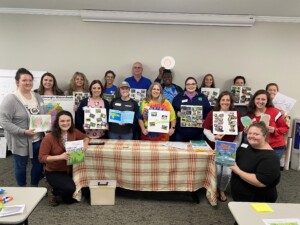PLT AND ME
Guest Blog by Kasey Bozeman
When I was 10 years old, I attended a Girl Scout summer day camp. In the morning, we did activities to earn badges. After eating our sack lunches, we spent the afternoon rotating among stations: arts and crafts, sports and games, and Project Learning Tree. I remember looking at tree cookies – such a fun name for a simple cross-section of a tree! We also drew rings of a tree to represent our life, showing growth with rings spread out, or perhaps tighter rings to represent the challenges. We even learned about tree products, like how sassafras and sarsaparilla were used as flavorings in root beer. I thought that was neat because my previous participation in 4-H Forestry judging taught me how to identify the leaves of a sassafras tree. At the end of the week, we got a patch for the back of our uniform vest with “Project Learning Tree” on it. While I didn’t know exactly what that meant, I did know that I learned a lot about trees and had a lot of fun.

Fast-forward 12 years, and I was serving as a County 4-H agent with the University of Georgia (UGA). UGA Extension is part of the College of Agricultural and Environmental Sciences and helps fulfill the land-grant university mission of outreach and service. With a strong network of offices located in every Georgia county, UGA Extension employs people to teach research-based information by assessing and identifying local needs. Having a personal interest in environment-related topics and wanting to expose the youth in my community to natural resource education, I completed the Project Learning Tree educator certification. Leaving that training with a huge book of activities and resources was so incredibly helpful. My county-level 4-H programs were already being taught in-school, after school, during summer camps, and as a partnership with other youth-serving organizations, like the recreation department. I quickly integrated Project Learning Tree into these sessions – from scattering pasta noodles for Birds and Bugs during a day camp to using the resources from Tree Factory to teach the Forestry Judging team about the parts of a tree. Project Learning Tree’s activities are easy-to-use, customizable, and engaging. Children are often learning science and other subject matters through participation, but the true purpose is for young people to learn how to think and not necessarily what to think.
Quickly developing a love for Project Learning Tree, I attended a certification a few years later that allowed me to then train others in using the resources. For nearly the past 10 years, I’ve led or co-led Project Learning Tree training for UGA Extension and 4-H employees, teachers, and various nature center employees across the state. I’ve enjoyed being able to empower these formal and nonformal educators to lead quality environmental education activities with young people, regardless of their prior knowledge or skill level. Even during the workshops, they begin to brainstorm ideas and suggestions for implementing the activities they just sampled, or see how they can better teach an educational standard or concept by using Project Learning Tree’s resources.

 In my current role as our 4-H Science specialist, my job is to ensure our faculty, staff, and volunteers have the tools and resources they need to be successful in teaching science. Last year in Georgia 4-H, we collectively served over 173,000 students across the state. Having great resources like Project Learning Tree makes my job so much easier. I’ve seen county 4-H programs plan an entire week of day camp programming using nothing but PLT! One of my favorite stories includes a County 4-H agent who was invited to the school’s family STEM night. She hid paper beetles throughout the school, and the attendees had to sniff and find the peppermint-scented beetles’ locations. After returning with their maps, the kids learned about scent and pheromones in the forest ecosystem, as well as learning if they were correct in their beetle findings! Another county that recently had both a staff member and volunteer get trained in PLT is now using this for their Homeschool 4-H meetings that reach 20 youth every week.
In my current role as our 4-H Science specialist, my job is to ensure our faculty, staff, and volunteers have the tools and resources they need to be successful in teaching science. Last year in Georgia 4-H, we collectively served over 173,000 students across the state. Having great resources like Project Learning Tree makes my job so much easier. I’ve seen county 4-H programs plan an entire week of day camp programming using nothing but PLT! One of my favorite stories includes a County 4-H agent who was invited to the school’s family STEM night. She hid paper beetles throughout the school, and the attendees had to sniff and find the peppermint-scented beetles’ locations. After returning with their maps, the kids learned about scent and pheromones in the forest ecosystem, as well as learning if they were correct in their beetle findings! Another county that recently had both a staff member and volunteer get trained in PLT is now using this for their Homeschool 4-H meetings that reach 20 youth every week.
Georgia 4-H is proud to be a partner with Project Learning Tree. It’s a natural alignment for us, and we are constantly urging our professionals to become certified educators. We’re very thankful to the state and national PLT staff that work so hard to ensure we have quality resources for our youth programming. As we continue to expand our natural resources education outreach efforts, Project Learning Tree will always be integrated into what we do. It’s so remarkable to me to see my own environmental education journey – from youth to adult – come full circle with Project Learning Tree!
